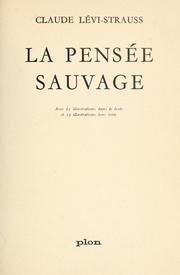The Savage Mind

Cover of the first edition
|
|
| Author | Claude Lévi-Strauss |
|---|---|
| Original title | La Pensée sauvage |
| Translator | Anonymous |
| Country | France |
| Language | French |
| Subject |
Anthropology Structuralism |
| Publisher | Librairie Plon (Paris) |
|
Publication date
|
1962 |
|
Published in English
|
1966 |
| Media type | |
The Savage Mind (French: La Pensée sauvage) is a 1962 work of structural anthropology by Claude Lévi-Strauss. The English translation appeared in 1966.
Lévi-Strauss makes clear that "la pensée sauvage" refers not to the discrete mind of any particular type of human, but rather to 'untamed' human thought: "In this book it is neither the mind of savages nor that of primitive or archaic humanity, but rather mind in its untamed state as distinct from mind cultivated or domesticated for the purpose of yielding a return." (219)
Savage thought, Lévi-Strauss argues, continually gathers and applies structures wherever they can be used. If scientific thought is represented by the engineer who asks a question and tries to design an optimal or complete solution, savage thought resembles the bricoleur, who constructs things using whatever materials are at hand.
One of Lévi-Strauss's many examples is the relationship between two Australian groups, the Aranda and the Arabanna. The Aranda have a complex system for intermarriages that divides all people into two groups and then four stages within each group. The system specifies where the children will live and how they will marry. The Arabanna use a different system for marriages, but somehow use the Aranda's marriage system for determining the sex and affiliation of reincarnated spirits. The structure has been borrowed and transposed, appropriated because of its ability to generate a certain economy independently of its substrate.
Lévi-Strauss (continuing the argument in Totemism, his previous work) criticizes the concept of totemism for arbitrarily prioritizing a particular structural relation. He admits the reality of totemism, in which, within a larger group, smaller groups distinguish themselves through identification with a plant or animal. He denies, however, that totemic societies differ fundamentally from societies that divide people on the basis of caste. Totems, he argues, are just another way to create necessary distinctions within a larger group. These distinctions may have greater or lesser practical significance, but ultimately:
In other words, the operation of identifying with a totem is secondary to the underlying process of re-appropriating structure (for example, observed differences between animals) for the purposes of society.
The Savage Mind was one of the earliest works of structural anthropology and had a large influence on the field of anthropology.
...
Wikipedia
